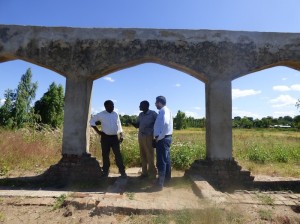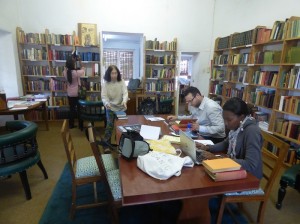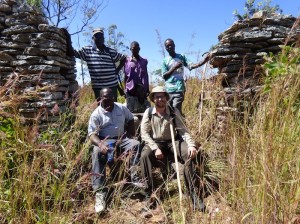MA Field Study Projects: Management Plan for Malawi Slave Trade Heritage Route and Dr. David Livingstone Trail
As part of fulfilling our MA in Heritage Management, we have started field research which will lead to designing and preparing a management plan for the Slave Trade Heritage Route and Dr. David Livingstone trail in Malawi. The Government of Malawi, through the Department of Antiquities, has nominated this series of sites on the UNESCO Tentative List.
To continue with the efforts done by the Malawi Government and UNESCO, we would like to document these sites, re-assess their values, carryout condition assessments, analyze and identify the stakeholders, and later, propose the best practice to better manage, protect and enhance these sites.
History & Background
Slave trade was introduced in Malawi by the Swahili-Arab traders in the 19th Century. The main slave routes within Malawi were Nkhotakota, Karonga, Mangochi and Phalombe, where the Swahili-Arabs and their Yao allies built their headquarters and stockades, organizing expeditions to capture slaves. These routes were the major terminus of the slaves throughout Central Africa going to the East African coast markets. At Nkhotakota, Jumbe, a Yao local chief, would send about 20,000 slaves annually to the market of Kilwa.
Dr. David Livingstone, a Scottish missionary and explorer, visited Nkhotakota in1861 where he witnessed slave trade at its peak. He got horrified in the way slaves were handled at Jumbe’s stockade and he described it as “a place of bloodshed and lawlessness”. In 1864 David Livingstone visited Nkhotakota again and met Jumbe. He was able to secure a treaty between Jumbe and Chewa Chiefs to stop slave trade and hostilities between them. However, the treaty did not last long as Jumbe continued with slave trade. It was up until Nyasaland came under the British protectorate in 1891 that slave trade completely came to an end.
It is important that this heritage be preserved to keep this memory alive for future generations to learn from. These routes are justified heritage because they also have a link to missionary work. When David Livingstone reported accounts of his experience on his second journey to Africa, he recommended that Christianity be introduced in the area to counteract slave trade activities. This led to the coming of important missionaries along the slave trade routes.
Goals & Objectives
To ensure effectiveness of our work, we have come up with the following objectives to serve as a compass to enable us get to our destination of coming up with a thorough, readily accessible and realistic management plan:
- To document sites related to slave trade heritage and Dr Livingstone trail in Malawi.
- To re-assess the site values and come up with a comprehensive statement of significance about slave trade heritage and Dr Livingstone trail in Malawi.
- To identify all relevant stakeholders and meet them to seek their views as far as slave trade heritage and Dr Livingstone trail in Malawi is concerned.
- To carry out site condition assessments.
- To propose best practices in management, conservation, research, tourism and marketing and education and awareness-raising programs for slave trade heritage and Dr Livingstone trail in Malawi.
Methodology & Timelines
A survey will be conducted to identify and map the stakeholders related to the project. To help carry out this survey, we are currently developing an informal questionnaire to distribute to stakeholders. Site surveys will also be used to assess the condition of the heritage sites. A condition assessment form will be used to record the conservation problems. Desk research will be used by reviewing some literature related to slavery and missionaries all around the world. Local libraries and archives will be visited to review the literature and old photographs.
Benefits & Anticipated Outcomes
We are of the firm view that this project will help the government of Malawi, the international community, local and international tour operators, schools and the local communities. The government of Malawi through the Department of Culture will use the results of the project to come up with strategies on how best to manage, promote and conserve the sites.
International communities like the UNESCO World Heritage Centre and ICOMOS will use this management plan document to evaluate the sites for listing on the World Heritage List.
When the proposed strategies of conservation and presentation initiatives have been implemented, tour operators will use the sites to give slave trade experience to the visitors.
The sites will also be used by researchers, school educators and students to study and learn about the history and practices of slave trade and missionary activities in the whole world.
Conclusion
The team is very optimistic that documenting and preparing this management plan will bring a new sense of urgency and commitment to heritage management in Malawi, especially in the protection of slave trade history and the activities of missionaries in Eastern African, and by extension Africa as a whole.
For the team members, this practical exercise is opening us up to new experiences and challenges in documenting and dealing with stakeholders and how to innovate, improvise, and engage with them in order to achieve our primary goals of a management plan.
These slave trade routes are rare and unique heritage sites in Malawi which record the memories of hardship and inhumanity which the people of Malawi and the entire world went through in the 19th Century. It is important that this heritage be preserved to keep this memory alive for future generations to learn from.
 Oris Malijani is a Cultural Heritage Officer in the Malawi Ministry of Tourism and Culture under the Antiquities Department and a 2013/2014 HERMA student. He has a background in Geography as well as conservation and management of immovable cultural heritage. His research interests include archaeology, fundraising for cultural organizations and heritage for development.
Oris Malijani is a Cultural Heritage Officer in the Malawi Ministry of Tourism and Culture under the Antiquities Department and a 2013/2014 HERMA student. He has a background in Geography as well as conservation and management of immovable cultural heritage. His research interests include archaeology, fundraising for cultural organizations and heritage for development.






